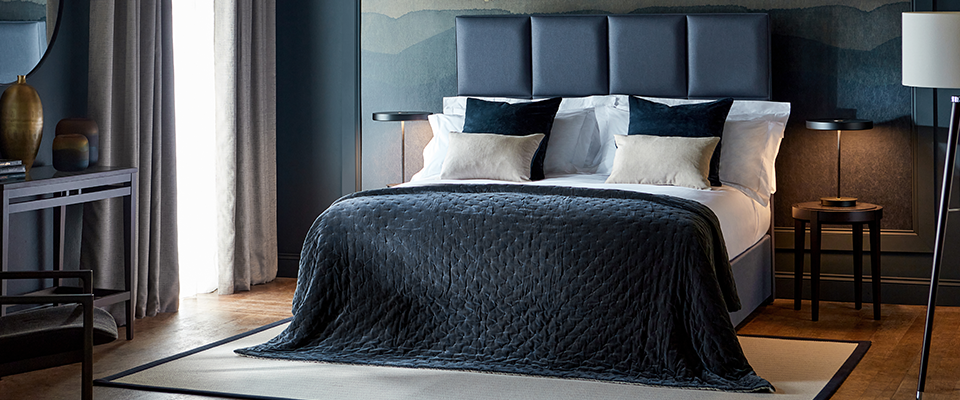Biophilic Design: The Latest Trend Set To Spring Into Hospitality Interior Design

If the pandemic has taught us anything, it’s the importance of our wellbeing, and there is no stronger influence than nature and the outdoors when it comes to creating a sense of calm and tranquillity.
Here, Carolyn Mitchell, Sales and Marketing Director at Hypnos Contract Beds, discusses how the hospitality sector is taking its lead from the natural environment to bring greater personal wellbeing to its guests via biophilic design...
Taking inspiration from nature is nothing new when it comes to interiors, however biophilic design enables hoteliers to delve deeper into the benefits that nature can offer when looking to create a space that enhances the wellbeing of its occupants.
As we all seek to enjoy a greater sense of serenity, coupled with the increasing importance consumers are placing on sustainability, it is little wonder that many hotels are looking to take advantage of the benefits that biophilic design offers to further shape and enhance the experience they offer to their guests.
From small steps which create a direct connection with nature, such as using plants, light and water, to incorporating more indirect design elements that offer a subtle link with the environment, such as nature-inspired artwork and furniture made with natural materials, there are many ways in which biophilic design works to satisfy the needs of those guests looking for an experience that draws on nature, is better for the environment and provides them with a stay that revitalises their sense of wellbeing.
The biophilic approach of space and place is also becoming increasingly important to hospitality offerings looking to create a fully holistic experience, where the use of architectural design elements such as balconies overlooking plush green gardens, hidden alcoves, subtle lighting changes, wooden decking or even bridges over a pond or lake are proving increasingly popular.

So how do you incorporate this type of natural aesthetic or feeling into your hotel?
The key to creating a sanctuary where people feel protected and healthy is to tap into all of a guest’s senses including smells, sights and sounds.
Access to natural ventilation for example, through outdoor spaces like balconies or large bi-folding doors, advanced air filtration systems and large, open well-lit spaces all have a role to play in creating a well-rounded, relaxing stay.
Utilising natural, tactile materials in the décor of a room or communal space is an easy way to give a nod to the trend without having to invest in a full remodel of an area. For example, reclaimed or ethically sourced wood furnishings and materials such as cork organic cotton, linen, hessian, wicker, leather and natural stone can all be used to instantly create a natural feel. Attention grabbing plants and water features, and soothing sounds of rainfall or a tranquil water feature are also simple touches that can help to awaken the senses.
Bringing unexpected or uncommon elements from the outside, indoors also works well to cultivate the feeling of nature in a surprising and eye-catching way. A living plant, moss or flower wall, or even an ‘indoor tree’, are extra special touches that can deliver a real wow-factor, whilst a ‘signature scent’ can be a powerful tool in cultivating a calming and restful environment.
Most importantly...
Creating an en-pointe biophilic design is one thing, but it means nothing if the furnishings themselves haven’t been sustainably or ethically sourced. A truly effective biophilic interior integrates the outside with the inside in a seamless, soothing and most importantly, sustainable way.
Opting for natural fibres that are 100% biodegradable or recyclable at the end of their life, particularly when considering dining tables, beds or sofas can help to ensure a sustainable approach is taken throughout the entire design process. Furniture or décor made from FSC certified wood and natural, ethically sourced materials, and fittings and furniture are free of harmful and allergy-related materials or chemicals also contribute to creating a healthy and happy stay.
Working with ethical partners who are equally committed to a sustainability first approach can help to ensure hotels can become a true advocate for biophilic design. For example Hypnos are proud to offer hoteliers eco-sleep solutions with the introduction of their Hospitality Origins Collection, meaning the mattresses are recyclable and never need to go to landfill. They use wool from Red Tractor assured farms, and cotton from the Better Cotton initiative, emphasising their acceleration to traceable and responsible sourced material. Moreover, they use fibre made from recycled plastic bottles which are traceable via the Global Recycled Standard.
By embedding sustainability at every touchpoint of the design process, including holding their suppliers to the same standard, hoteliers can ensure they’re doing their part in creating safe, ethical interiors, whilst offering their consumers the supremely ethical experience that makes them feel good for all the right reasons.
